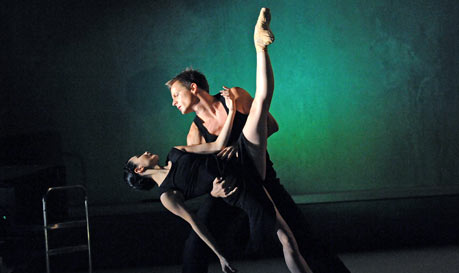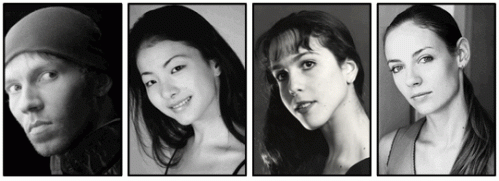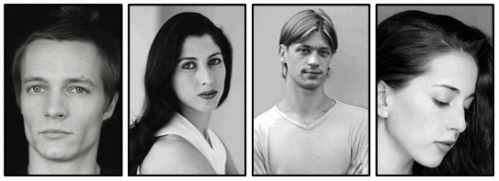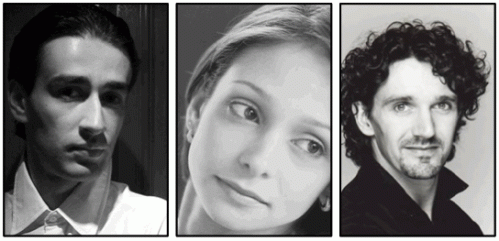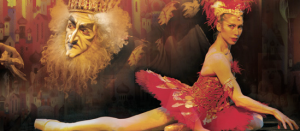
Kim Brandstrup. Copyright belongs to its owners. Source: GBCM
While at the main stage the Royal Ballet season kicks off in October with Mayerling, downstairs at the Linbury Studio the ROH2, Royal Opera House’s contemporary arm, makes a headstart next week with an exciting new collaboration between dancers Tamara Rojo, Thomas Whitehead, Steven McRae and choreographer Kim Brandstrup. Then, later in the season, Brandstrup goes back to the main stage for a repeat of his acclaimed one act ballet, Rushes – Fragments of a Lost Story. Based on one of the preliminary outlines for Dostoevsky’s novel The Idiot and influenced by socialist realist movie aesthetic, the ballet furthered his range as a leading narrative choreographer.
With Brandstrup’s film school background it was natural that a ballet called Rushes (the name refers to raw, unedited film scenes) should contain all forms of reference and reverence to cinema, with its non linear narrative and action that takes place behind beaded curtains, just like a grainy movie from the 30’s. Movie-like structures are something of a leitmotif in his works, and in the past he has spoken of his rejection of classical ballet’s literal or linear plot development as compared to “film cuts” (see “in his own words” below). However, Brandstrup’s forthcoming Goldberg project with Tamara Rojo seems an altogether different proposition, an experiment with “other ways of moving”, using Bach’s Goldberg Variations and drawing subtleties and “things that go unnoticed in big stages” to the intimacy of the Linbury Studio. More information on this project can be found in a recent interview Brandstrup gave to dance writer Jane Simpson now posted to Ballet.co.uk.
Kim Brandstrup in a Nutshell
Born in Arhus, Denmark in 1956, the son of a contemporary artist, Kim attended a progressive school which encouraged creativity. He initially studied film at the University of Copenhagen, but switched to modern dance studies at age 19.
He moved to London in 1980 to study at the London School of Contemporary Dance where Nina Fonaroff was his teacher.
Kim founded his own company, Arc, in 1985 (Arc is currently in the backburner but he plans to bring it back, not as a full time company but on a project by project basis).
In 1989 he won the Olivier award for “Outstanding Achievement in Dance” with Orfeo, a piece he choreographed for the now extinct London Contemporary Dance Theatre.
The cinema never ceased to be an influence in his work, along with literature. Kim worked with Irek Mukhamedov on a commission of Othello (winner of the London Evening Standard Award for Most Outstanding Production) and created for his own company pieces such as Elegy which drew on characters from The Idiot and later Elegy’s enlarged version (Brothers) inspired by two other Dostoevskian tales.
He has choreographed for the Royal Danish Ballet, the Rambert Dance Company, English National Ballet, Birmingham Royal Ballet and other companies in the UK and abroad. He has been working with the Royal Ballet since 2003, having created dances for principals such as Carlos Acosta, Tamara Rojo, Zenaida Yanowsky, Leanne Benjamin, Steven McRae, Laura Morera, Alina Cojocaru and Johan Kobborg.
Kim also works regularly with opera directors. One of his best known collaborations in this field was with director Phyllida Lloyd for Debussy’s one act opera “The Fall of the House of Usher”, where he choreographed the opening sequence featuring four dancing doubles of the opera characters, as performed by Steven McRae, Gary Avis, Leanne Benjamin and Johannes Stepanek. (This 2006 production is available on DVD).
He says his creations are triggered by the dancers he works with even if the music, theme or narrative have been chosen well in advance. For him, being in the studio with a particular dancer transforms a piece from concept to reality, tailoring the movement to their particular strengths and characteristics.
For Rushes he chose a rare, unpublished Prokofiev movie score (composed for a shelved film adaptation of The Queen of Spades) which he tracked from a tiny footnote in an article mentioning the score’s existence, liasing with a Princeton scholar and finally finding a copy in the Prokofiev archives at Goldsmiths College. What attracted Brandstrup was the structural freedom it gave him, the music was meant to be played underneath a dialogue so it was done in short, concise numbers.
In his own words:
Everyone says I have done narrative ballets but I have never tried to use narrative in a traditional way
My preparation is not steps, not even a story. I listen and listen until the music has become second nature, it has to be in the bloodstream.
The dancers are the second ‘given’ when you work with an established, full-time company. First there is the music, the theme, the place in the programme, which is stipulated when you are first asked, then comes – and this is the most important – the dancers. If they don’t inspire you, then you can’t do it, no matter how prestigious or exciting the project might be.
In a ballet you have a location and people acting in it in real time – 45 minutes in a castle, 45 minutes in a forest, 45 minutes at a wedding.” Whereas in film one event cuts to another and time is not literal.
When I studied film, everything that I loved about it was not verbal, it was the silent films. And when you look at a director like Hitchcock you’ll find that 60 or 70 per cent is purely visual and it’s through the images that the story is told.
She’s a remarkable artist she has such focus and power on stage which gives her a real dramatic hold over an audience. (on Tamara Rojo)
Extract of Reviews and Selected Praise:
Of his Two Footnotes to Ashton, Linbury Studio
Brandstrup’s bucolic Two Footnotes to Ashton is particularly captivating, a frolicsome and erotic footnote to La Fille mal gardée, with Johan Kobborg as a bare-chested, very surprised yokel on whom Alina Cojocaru insistently pounces like a tiny little cat on heat. Everything about this duet is seductive – the recording of Cecilia Bartoli at her most irresistibly honeyed in Gluck’s “Di questa centra in seno”; the way Cojocaru sexily nudges dopey Kobborg with her head and then unleashes lethal vertical arabesques; and the final sweetness of his succumbing, holding her hovering body over his in a delicious anticipation. A total charmer, truly Ashtonian, and surely likely to reappear for the pair on gala occasions. Ismene Brown at the Telegraph [link]
It was Kim Brandstrup who lived up to the evening’s title. His Footnotes was set to ravishing arias (Gluck, Handel), ravishingly sung by Bartoli and Kozena, ravishingly realised (Cojocaru and Johan Kobborg pouring out feeling as a whirlwind of turns and poses; Zenaida Yanowsky grieving wonderfully), and ravishingly made. Clement Crisp at the Financial Times [link]
Of Pulcinella, Birmingham Royal Ballet
Cleverly, Brandstrup depicts Pulcinella as a puppet who has somehow slipped his strings, a giddy, quivering creature who alternates between blithe enthusiasm and doleful despair, and who can only just hold on to his spiky, streetwise girlfriend Pimpinella (Ambra Vallo). Some of his best writing is for these comically ill-assorted lovers, especially their wrangling duets in which tiny Vallo seems to batten on to [Robert] Parker’s body, her railing fists and flick-knifing limbs wheeling vociferously around him. Judith Mackrell at The Guardian [link]
Of Rushes
Acosta is caught in furious, impassioned dialogue with Morera (both artists grandly expressive) while there are appearances by Cojocaru as a compassionate “other” woman. Brandstrup’s writing is fluent, dark in tone for the Acosta/Morera partnership, the couple repeating with each new “rush” aspects of emotional turmoil that we have seen before. Cojocaru seems at first an observer (like the corps de ballet who inhabit the penumbra at the back of the stage). But Brandstrup has shown himself in past works to be an emotional optimist, and the final “rush” is an ecstatic duet for Cojocaru and Acosta which suggests an assertion of possible happiness. Here is a fascinating (and visually very stylish) ballet that will repay further viewings. I hope to return to it, and the rest of this triple bill, after a later performance. Clement Crisp at The Financial Times [link]
In keeping with the theme of Brandstrup’s ballet, all that existed of the music was a couple of dozen fragments, which Michael Berkeley has worked up into an immediately appealing and very danceable whole. Brandstrup picks his collaborators with an unerring eye and ear, and his ballets have a sense of completeness which is quite rare. Jane Simpson review for Dance Now (Vol. 17 No. 2 Summer 2008)
Where to see Kim Brandstrup’s Work:
- Goldberg – The Brandstrup-Rojo Project – 21 to 26 September at the Linbury Studio
- New Watkins/Rushes – Fragments of a Lost Story/Infra – 19/26 Feb 1/2/4 March 2010 – ROH main stage
- MK Ballerina – 20 May to 5 June – The Royal Danish Theatre
- MK Danseur Noble – 21 May to 5 June – The Royal Danish Theatre
Videos
Sources and Further Information:
- Brandstrup’s Official Website [link]
- Biography from Birmingham Royal Ballet website [link]
- Biography from GBCM website [link]
- New Rojo/Brandstrup work feature by Amanda Holloway. ROH About the House magazine – April 2009
- Kim Brandstrup feature by Allen Robertson. ROH About the House magazine – Sept 2007
- Performance Notes and Programme for Rushes (2008) including article “Kim Brandstrup” by Judith Mackrell
- Kim Brandstrup: Arcing back from the abyss by Nadine Meisner for The Independent [link]
- Kim Brandstrup’s Brothers reviewed by Ismene Brown for The Telegraph [link]
- Kim Brandstrup’s work listings at Loesje Sanders’ Website [link]
- Theorising Brandstrup at Work, a conversation with Susan Melrose and Steffi Sachsenmaier [link]
- Claude Debussy – The Fall of the House of Usher · Prélude à la l’après-midi d’un Faune · Jeux (Bregenzer Festspiele 2006) DVD [link]
Read Full Post »



